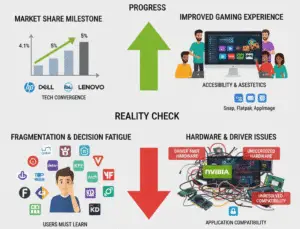
🌐 Mastering Networking Basics: The Ultimate Guide for IT Professionals
In today’s digital world, networking is the backbone of every IT system—from small home setups to global enterprise infrastructures. Whether you’re troubleshooting connectivity issues, optimizing performance, or securing data, understanding core networking concepts is essential.
This guide breaks down must-know networking fundamentals in simple terms with real-world examples. Let’s dive in!
 What is a Network?
What is a Network?
A network connects two or more devices (computers, servers, printers) to share data and resources.
Types of Networks:
| Type | Full Form | Coverage | Example |
|---|---|---|---|
| LAN | Local Area Network | Small area (home, office) | Wi-Fi at your house |
| WAN | Wide Area Network | Large geographic (countries) | The Internet |
| MAN | Metropolitan Area Network | City-wide | University campuses |
| PAN | Personal Area Network | Very short range (10m) | Bluetooth devices |
| CAN | Campus Area Network | Multiple buildings | Corporate offices |
Why it matters?
-
LANs help offices share files quickly.
-
WANs connect global businesses.
 Switches: The Traffic Directors of a LAN
Switches: The Traffic Directors of a LAN
A switch connects devices in a LAN and forwards data using MAC addresses.
Types of Switches:
| Type | Features | Best For |
|---|---|---|
| Unmanaged | Plug-and-play, no configuration | Home networks |
| Managed | Full control (VLANs, QoS) | Businesses |
| Smart | Limited management | Small offices |
| Layer 3 | Can route between VLANs | Large networks |
Example:
-
Your office uses a managed switch to separate HR and Finance departments into different VLANs.
 Routers: The Internet Traffic Police
Routers: The Internet Traffic Police
A router connects different networks (like your LAN to the Internet) and routes data using IP addresses.
Routing Types:
| Type | How It Works | Use Case |
|---|---|---|
| Static | Manually set routes | Small networks |
| Dynamic | Automatically updates (OSPF, EIGRP) | Large networks |
| Default | Sends traffic to a gateway | Home routers |
Real-World Scenario:
-
Your home Wi-Fi router uses default routing to send all traffic to your ISP.
 VLANs: Virtual Networks Inside a Switch
VLANs: Virtual Networks Inside a Switch
A VLAN (Virtual LAN) splits a single switch into multiple isolated networks.
Common VLAN Types:
| VLAN Type | Purpose |
|---|---|
| Default | All ports start here (VLAN 1) |
| Data | Regular user traffic |
| Voice | Prioritizes VoIP calls |
| Management | For admin access |
| Native | Carries untagged traffic |
Why use VLANs?
-
Security: Isolate guest Wi-Fi from internal networks.
-
Performance: Reduce unnecessary broadcast traffic.
 Trunking: The VLAN Superhighway
Trunking: The VLAN Superhighway
A trunk link carries multiple VLANs over a single cable between switches.
Trunking Protocols:
| Protocol | Description |
|---|---|
| 802.1Q | Standard (Supports all vendors) |
| ISL | Cisco’s old proprietary protocol |
Example:
-
A school network uses 802.1Q trunking to separate student and staff VLANs across multiple switches.
 EtherChannel: Double the Bandwidth, Zero Downtime
EtherChannel: Double the Bandwidth, Zero Downtime
EtherChannel combines multiple physical links into one logical link for:

EtherChannel Protocols:
| Protocol | Type | Vendor Support |
|---|---|---|
| PAgP | Cisco’s proprietary | Cisco only |
| LACP | Industry standard | All vendors |
| Static | Manual setup | No negotiation |
Use Case:
-
A data center uses LACP to bond four 10Gbps links into a 40Gbps connection.
 STP: Preventing Network Loops
STP: Preventing Network Loops
Spanning Tree Protocol (STP) stops broadcast storms by blocking redundant paths.
STP Types:
| Protocol | Speed | Use Case |
|---|---|---|
| STP | Slow (50 sec convergence) | Legacy networks |
| RSTP | Fast (2 sec convergence) | Modern networks |
| MSTP | Multiple VLANs | Large enterprises |
Why it matters?
-
Without STP, a misconfigured switch could crash the entire network.
 ACLs: The Network Bouncer
ACLs: The Network Bouncer
An Access Control List (ACL) filters traffic based on rules.
ACL Types:
| Type | What It Filters | Example |
|---|---|---|
| Standard | Only source IP | Block 192.168.1.10 |
| Extended | IP, port, protocol | Block Facebook (TCP 443) |
| Named | Easier to manage | “BLOCK_SOCIAL_MEDIA” |
Real-World Use:
-
A company uses an ACL to block employees from accessing gaming sites.
 NAT: Hiding Private IPs Behind One Public IP
NAT: Hiding Private IPs Behind One Public IP
NAT (Network Address Translation) converts private IPs (192.168.x.x) to a public IP.
NAT Types:
| Type | How It Works | Example |
|---|---|---|
| Static | 1 private IP → 1 public IP | Web servers |
| Dynamic | Pool of public IPs | Offices |
| PAT (Overload) | Many private IPs → 1 public IP | Home Wi-Fi |
Why NAT?
-
Saves IPv4 addresses (your whole home shares one public IP).
 VPNs: Secure Remote Access
VPNs: Secure Remote Access
A VPN (Virtual Private Network) encrypts connections over the Internet.
VPN Types:
| Type | Use Case |
|---|---|
| Site-to-Site | Connects two offices |
| Remote Access | Employees working from home |
| SSL VPN | Web-based secure access |
| IPSec VPN | Encrypted tunnels |
Example:
-
You use a VPN to securely access work files from a coffee shop.
Final Thoughts
Networking is the foundation of IT. Mastering these concepts helps you:






